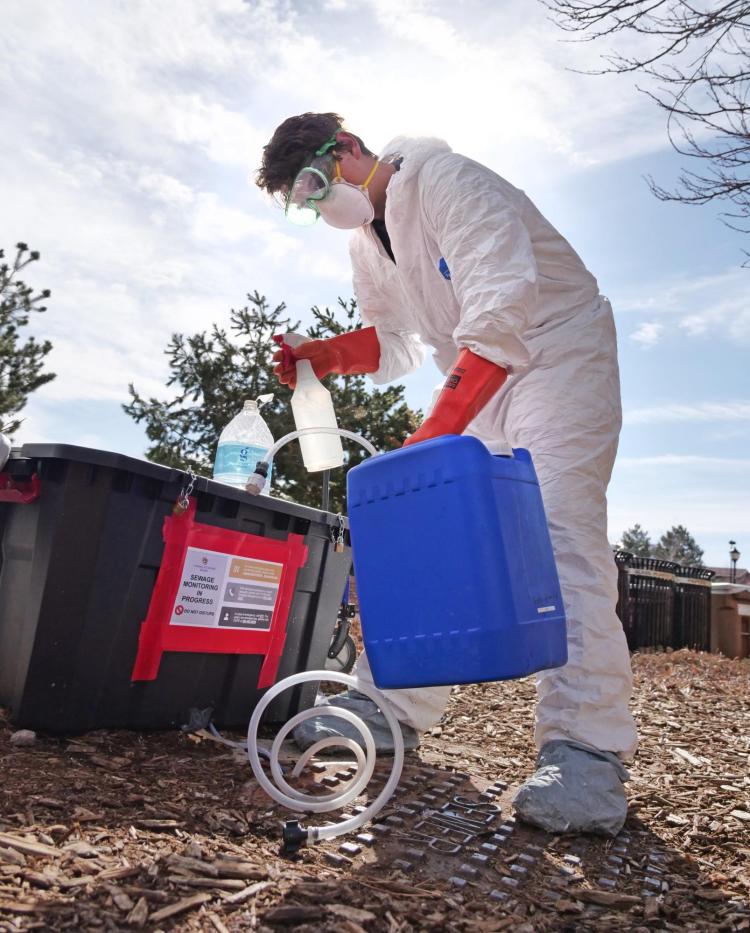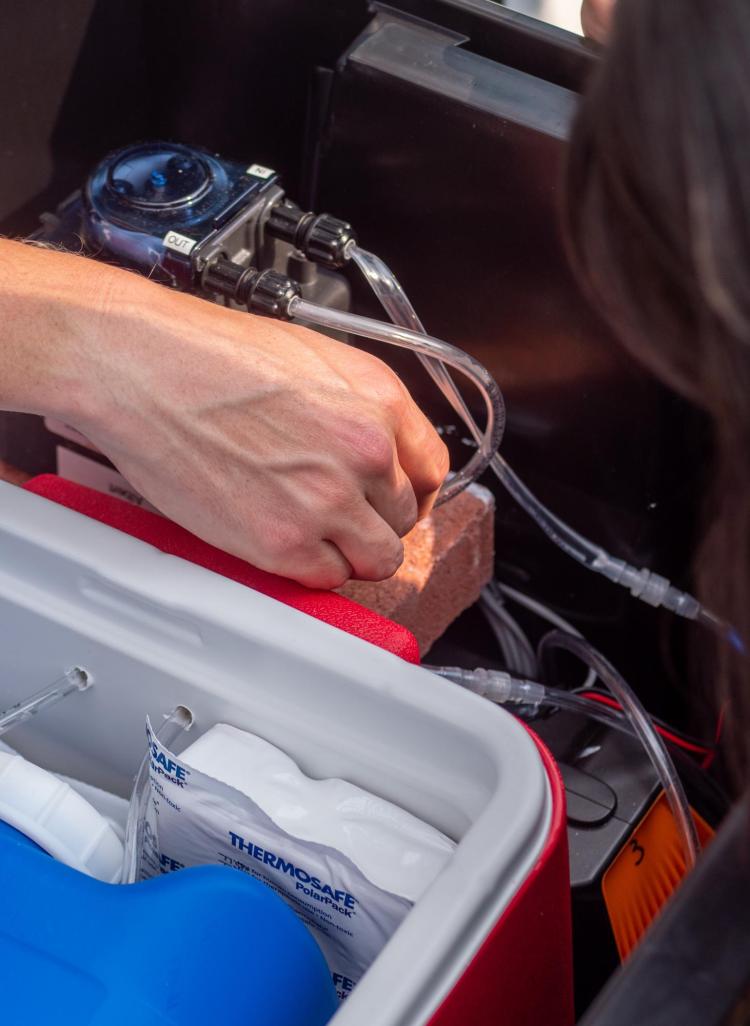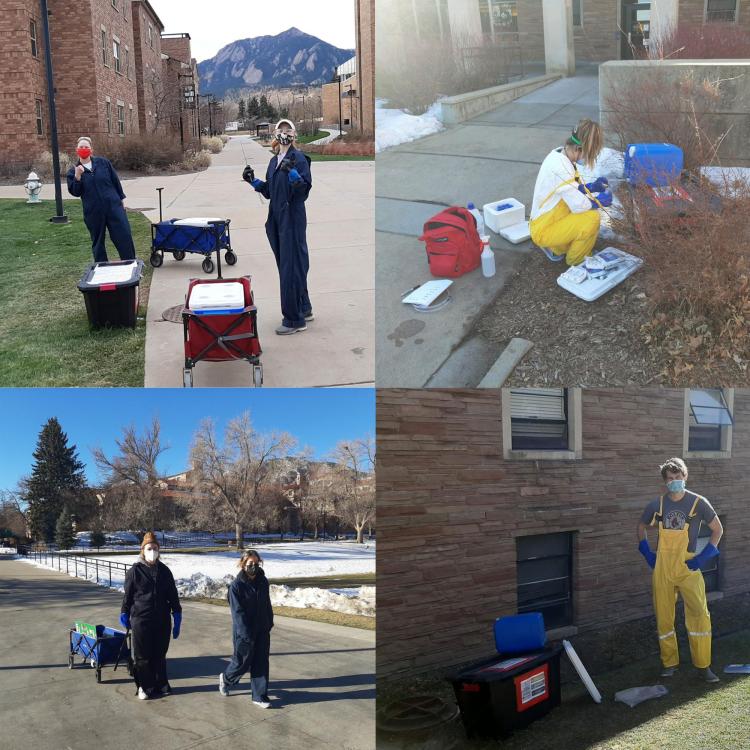Not a moment to waste: How a resource beneath our campus has been key during COVID-19
It’s a chilly spring morning in March 2021 and campus is quiet. Dew hangs on blades of grass. Songbirds chirp from the trees, while a few students speed by on their bikes and skateboards.
But while campus may seem calm, an artificial river flows underneath, holding a wealth of information about levels of SARS-COV-2, the virus that causes COVID-19, circulating in the world above.
The only visible sign of this rich world below is a series of nondescript black plastic tubs sitting out on the lawns.
Top: PJ from Reno, Nevada, who graduated from CU Boulder environmental engineering, conducts COVID-19 wastewater testing on the CU Boulder campus in March of 2021. (Credit: Casey A. Cass/CU Boulder) Bottom: Cresten Mansfeldt and Katelyn Reeves examine a wastewater monitoring station that collects wastewater from the Kittredge residence hall complex in August of 2020. (Credit: Glenn Asakawa/CU Boulder)
Cresten Mansfeldt, assistant professor of civil, environmental and architectural engineering, stands double-masked and in a cable knit sweater, surrounded by residence halls, pointing out some of the 23 sampling stations carefully laid across campus to catch samples from the sewers below.
Since the stations were first installed and turned on in August of 2020, a team of 35 undergrads, graduate students and alumni have collected over 3,000 samples and run more than 4,700 tests over at least 140 days.
While last fall there was a clear signal of SARS-COV-2 in their samples, this spring the data is showing levels of the virus are over 1,000 times less. More than 80% of sites don’t even detect it on a given day. It’s a strong sign that the hard work of students, staff and faculty to reduce the spread of COVID-19 is paying off.
These snapshots of what’s in our wastewater have been critical to keeping campus safe during the pandemic—and systems like it could even help us catch the next one.
“We’re moving away from the concept of this source as a waste, but seeing it instead as a resource,” said Mansfeldt.
An early warning signal
Undergraduate students collect samples across campus in spring of 2021. (Credit: Cresten Mansfeldt)
After COVID-19 caused CU Boulder to switch to remote learning in March of 2020, conversations soon followed in May about what would need to happen to open campus for the fall semester. Roy Parker, professor of biochemistry, and the campus planning committee that oversaw the safe return to campus in the fall of 2020, initiated this unique wastewater monitoring initiative. Mansfeldt, who is trained in environmental engineering and environmental microbiology, was asked to lead it. It’s been his top priority since.
Environmental engineering linked medical data and sewage data very early on in the pandemic, moving it from proof of concept to direct application almost immediately, said Mansfeldt.
“It’s no longer a theoretical application,” he said. “If you're going to do testing on campus, you probably should also monitor your sewage.”
While CU implemented a comprehensive framework of individual testing, contact tracing and enhanced ventilation on campus, this non-invasive surveillance system has done what nothing else could: Provide an early warning signal.
Since about 40% to 80% of people infected with SARS-COV-2 shed it in their waste, testing for it in our sewers has enabled CU Boulder to detect infections almost a week before someone might exhibit symptoms. This has allowed campus to deploy targeted testing to residence halls which could be on the cusp of an outbreak.
The beauty of this data is that it requires no public participation and is completely anonymous. The most detailed it can get down to is to a building, not a person.
“This testing has complemented and advanced the individual testing, because you don't need user buy in—you already have user buy in,” said Mansfeldt.
From manholes to morale
The wastewater stations are straightforward: A battery-powered pump constantly pulls a small amount out of the sewage below through a thin tube, which is stored in a container surrounded by ice packs and insulation to keep it cool. Every day, a member of the team collects a sample from each station and brings it back to the lab for analysis.
But this summary understates the complexity and commitment involved.
This fall, Mansfeldt traded his daily routine of running for weightlifting, learning to carefully lift manhole covers which clock in at a hefty 250 pounds, in order to install and maintain the sites. He has not only been responsible for a large bulk of the initial fieldwork and the team’s safety and scheduling, but he has worked equally hard to keep up their morale as temperatures dropped over the winter.
“I was often buying hot chocolate and coffee just to keep everybody's spirits up,” he said.
After a long day of checking the stations and collecting samples, the testing—conducted by a separate, small team of alumni in the Jennie Smoly Caruthers Biotechnology Building—often wouldn’t return results until 10 or 11 p.m. Then they’d go back out the next day and do it all again.
This spring, the field team has expanded and now does the analysis in their own lab on campus, so their results come in closer to the end of a typical workday. But it’s still been demanding, and dramatic weather changes have provided an additional challenge.
Mansfeldt joined CU in the fall of 2019, only half a year before the pandemic took over and this project began in earnest. But for him and his team, the end may now be in sight. If the virus remains under control, the team plans to shut it off after the semester concludes this May.
Top: Professor Cresten Mansfeldt has been leading the COVID-19 wastewater testing at CU Boulder. (Credit: Casey A. Cass/CU Boulder) Bottom: Katelyn Reeves, an environmental engineering graduate student, is one of a team of 35 undergrads, graduate students and alumni who have worked with assistant professor Cresten Mansfeldt to implement a wastewater monitoring systems that collects wastewater from residence hall complexes. (Credit: Glenn Asakawa/CU Boulder)
Commitment, credit and careers
While the campus monitoring system will likely soon wrap up, its impact on students and the field of environmental engineering will last much longer. The CU Boulder system and similar projects across the country, developed in response to the pandemic, have shown the direct application of the profession.
For Elle Coe, a senior in environmental engineering, this past year hasn’t just been life-changing because of COVID-19: This project changed her career.
Coe was “dead set” on working in groundwater engineering after leaving CU Boulder, and already had her classes scheduled this year with that aim in mind. Yet she’s now switched to a career focused on wastewater and drinking water treatment, and has a full-time position in the field lined up after graduation.
Intrigued by the unique cross-disciplinary opportunity with Mansfeldt, team member William Johnson came back to school in 2020 and is now a graduate student in environmental engineering.
“I find the idea at the core of wastewater epidemiology—that our sewers are chock full of information—to be really compelling,” said Johnson.
Wastewater can also tell us a lot about the world around us, including helpful information for universities—even when not in a global pandemic—such as levels of annual influenza, pharmaceuticals and more. As the global population continues to grow and climate change starts to have more consequences, Mansfeldt notes that applied science and engineering like this project will become even more important.
For Jorge Vargas-Barriga, an undergraduate in the Environmental Engineering Program, this project has solidified the reason that he chose to major in environmental engineering: He wants to do work that meaningfully impacts communities. It also enabled him to do everything from fieldwork to lab work, helped battle his imposter syndrome and improved his sense of belonging as a first-generation person of color at CU.
“The amazing team that Cresten [Mansfeldt] has formed has absolutely made me feel more welcome than I have in a while, and I think that speaks to the individuals that make it up,” said Vargas-Barriga.
This feeling also rings true for Katelyn Reeves, who has worked with Mansfeldt since setting up the first sampling stations in August 2020 under a hot summer sun.
After she completed her MS here in civil engineering, Mansfeldt reached out to Reeves about joining the project as a PhD student. For her, every box was ticked: Hands-on, laboratory-based wastewater research with the potential to fight COVID-19 in the meantime.
“The truly most exciting thing about this project was the opportunity to take action amidst all the fear and uncertainty of the pandemic,” said Reeves.







